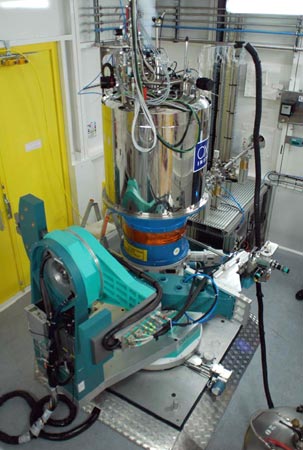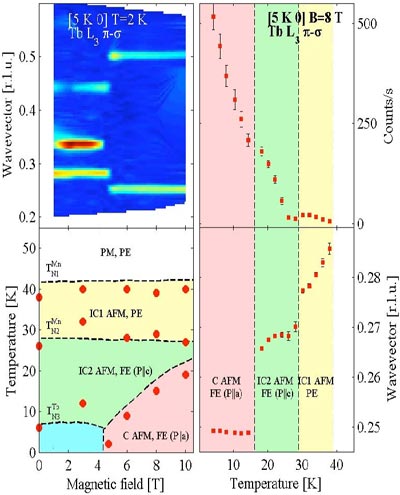- Home
- News
- Spotlight on Science
- Resonant X-ray Scattering...
Resonant X-ray Scattering under High Magnetic Fields
29-03-2006
Electronic degrees of freedom produce a wide range of fascinating ordering phenomena in materials which are both of fundamental and technological importance. Examples of everyday exploitation of these effects include magnetism used in the hard disks of our iPods, through to ferroelectric security chips on credit cards that allow us to safely download our favourite songs. Less familiar is the concept that these seemingly disparate effects can in fact be coupled. So-called multi-ferroic materials simultaneously display several types of long-range electronic order. Recently new families of rare-earth transition metal oxides have been discovered which display a surprisingly-large coupling between the ferroelectric and magnetic order parameters. This opens up novel possibilities to control magnetism with electric fields, or correspondingly to manipulate ferroelectricity by magnetic fields.
Share
The recently commissioned high-field magnet facility on ID20 (see Figure 1) opens new avenues of research in materials with complex and competing order parameters, including multiferroics. In one of the first experiments using this facility the phase diagram of the multiferroic compound TbMnO3 was investigated. Bulk measurements had established that in zero applied magnetic field the ferroelectric polarization P aligns along the c-axis (see the phase labelled "FE (P//c)" Figure 2), while above a critical threshold of applied field, P flops to be along the a-axis (phase FE (P//a)). However, these measurements obviously do not provide a microscopic, or more precisely atomic-scale, description of changes to the structural and magnetic correlations. Such information is provided by scattering data, particularly X-ray resonant scattering with its element and electron shell sensitivities.
 |
|
Fig. 1: 10 T split coil superconducting magnet (Oxford Instruments Superconductivity) installed in the new ID20 experimental hutch on the six-circle normal beam diffractometer (Huber GmbH). |
Combining the advantages of X-ray resonant scattering (performed at both the Tb L- and Mn K-edges) with the new magnet facility allowed the phase diagram to be studied in great detail. For example, for all of the phases identified by the bulk studies we were able to study the underlying chemical and magnetic structures. As a result, the different commensurate (C) and incommensurate (IC) phases can be studied in details, and the contribution to the X-ray diffraction signals from Tb of Mn electrons can be distinguished as well as the corresponding magnetic and electronic modulations within each phase. This allowed us, amongst other things, to establish that the flop of the polarization along the a-axis is driven by an incommensurate to commensurate transition.
 |
Fig. 2: Resonant X-ray scattering results on the magnetic and anomalous scattering modulations of TbMnO3 as a function of the temperature (right panel) and magnetic field (left panel). |
Authors
D.F. McMorrow (a), D. Mannix (b), C. Mazzoli (c), S. Wilkins (c) and L. Paolasini (c).
(a) Dept. of Physics and Astronomy, University College London (UK)
(b) XMas beamline, ESRF
(c) ID20 beamline, ESRF



